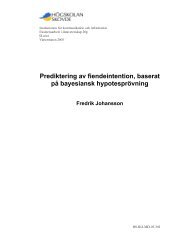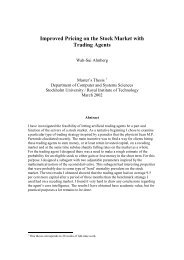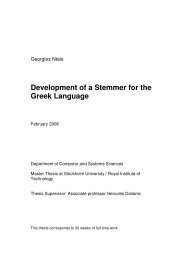Modeling Hydra Behavior Using Methods Founded in Behavior-Based Robotics
Modeling Hydra Behavior Using Methods Founded in ... - SAIS
Modeling Hydra Behavior Using Methods Founded in ... - SAIS
You also want an ePaper? Increase the reach of your titles
YUMPU automatically turns print PDFs into web optimized ePapers that Google loves.
Chapter 4<strong>Behavior</strong>-based roboticsAs mentioned <strong>in</strong> Chapter 1, BBR (<strong>in</strong> contrast with classical AI) takes a bottom-up approachto robotic behavior, and the complete robotic bra<strong>in</strong> is built from a repertoire ofsimple behaviors. It should be mentioned that, more recently, hybrid architectures 1 havebecome <strong>in</strong>creas<strong>in</strong>gly common [48], thus fill<strong>in</strong>g the gap between BBR and AI somewhat.This chapter provides a brief <strong>in</strong>troduction to the framework of BBR.The ma<strong>in</strong> characteristics of behavior-based systems are low-level <strong>in</strong>telligence, i.e. atight connection between the robot’s sensors and its actuators, and decomposition of therobot’s overall behavior <strong>in</strong>to <strong>in</strong>dividual behaviors, each of which represents a dist<strong>in</strong>ctfunctional unit [1]. The generation and, <strong>in</strong> particular, organization of behaviors constitutevast field of studies, and many methods have been suggested by researchers <strong>in</strong> the field. Itshould be noted that methods for the generation and organization of behaviors apply notonly to architectures <strong>in</strong> BBR, but also to most hybrid architectures [48]. More <strong>in</strong>formationconcern<strong>in</strong>g generation and organization of behaviors <strong>in</strong> BBR can be found e.g. <strong>in</strong> [1, 47,67, 71]. For a review of current methods used for behavior coord<strong>in</strong>ation, see e.g. [49].Generation and coord<strong>in</strong>ation of robot behaviors can be accomplished by means ofhand-cod<strong>in</strong>g and traditional eng<strong>in</strong>eer<strong>in</strong>g techniques, or by means of artificial evolution,<strong>in</strong> which evolutionary algorithms (EAs) [25] are used as an optimization method. Thelatter case forms the field of evolutionary robotics (ER) [42]. A brief <strong>in</strong>troduction toEAs is provided <strong>in</strong> Appendix A.4.1 Generation of robot behaviorsAs previously mentioned, <strong>in</strong> BBR relatively simple behaviors constitute the build<strong>in</strong>gblocks of the robotic bra<strong>in</strong>. Several architectures for behaviors exist, e.g. if-then-else-1 Comb<strong>in</strong><strong>in</strong>g reactive behaviors from BBR, and deliberative plans from traditional AI.13





